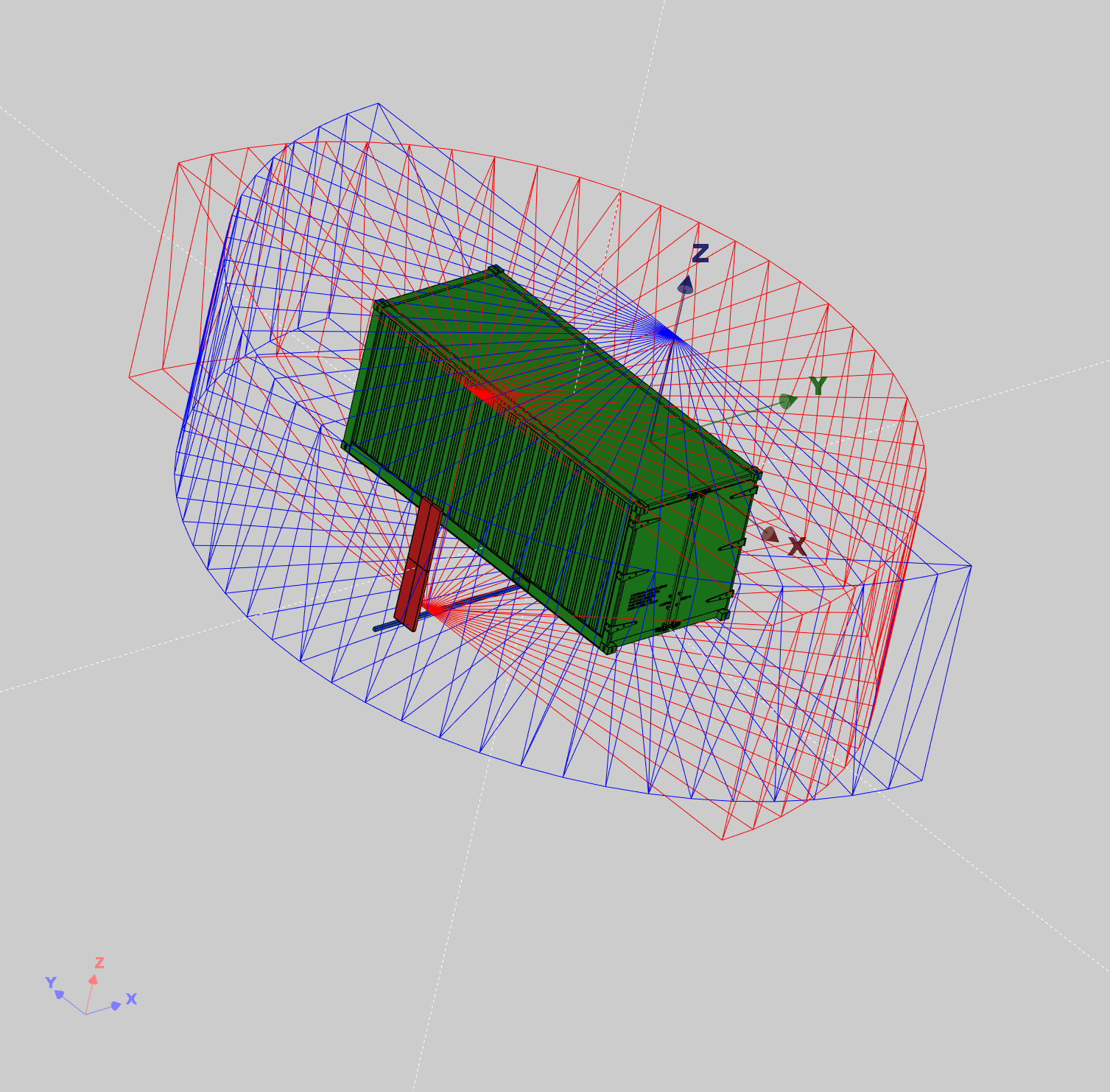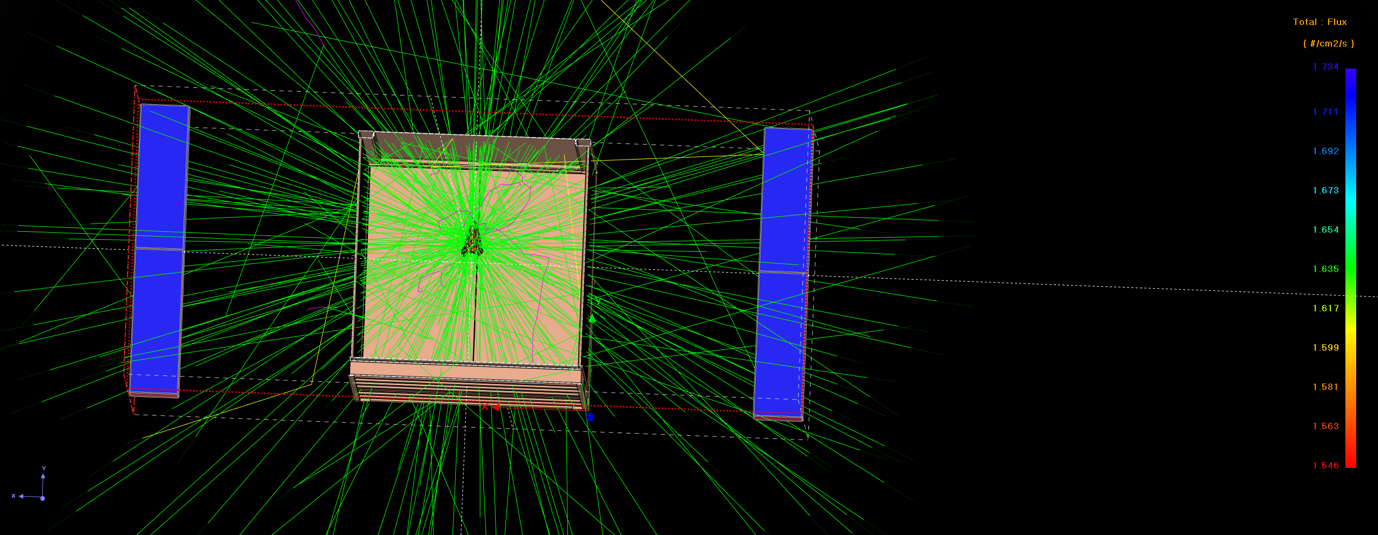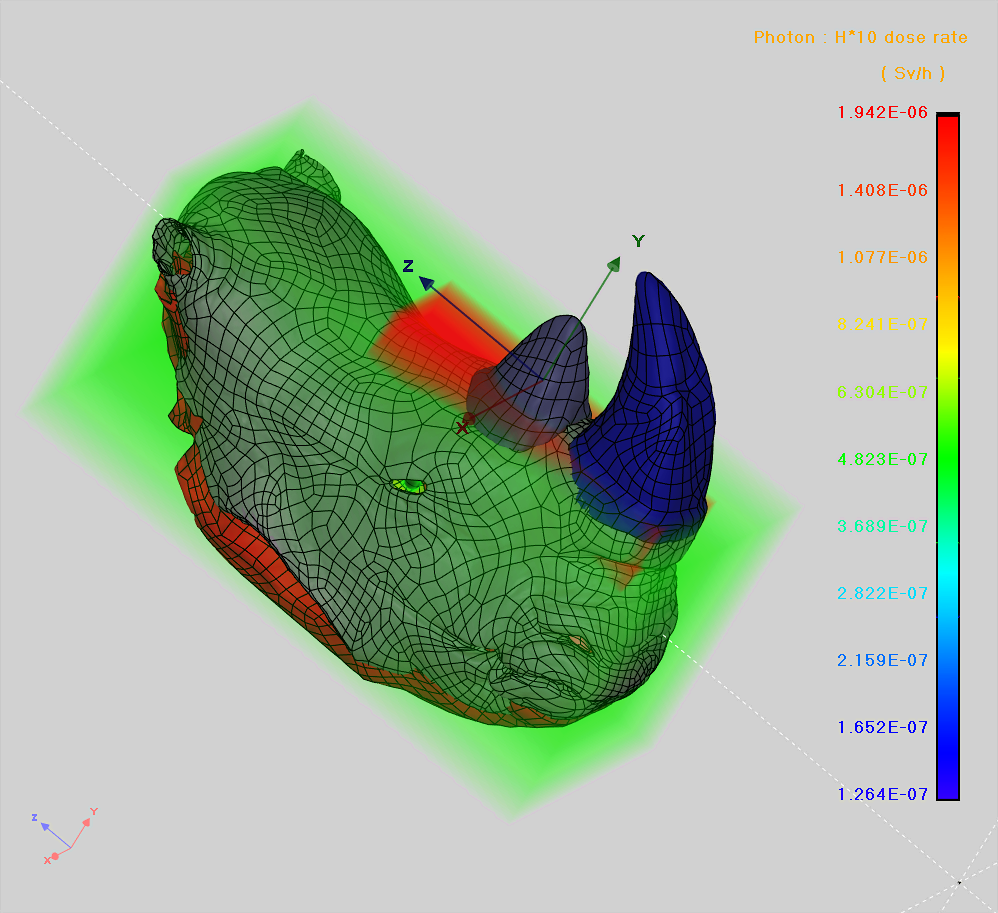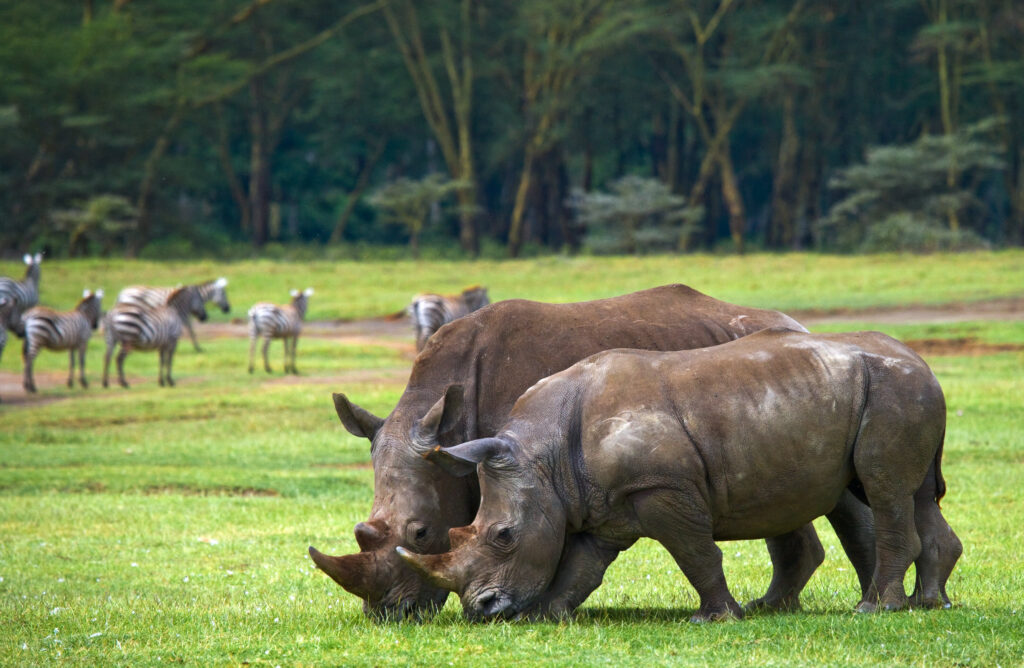“Science saving Rhinos. Rhinos Saving People. People Saving Rhinos.”
THE RHISOTOPE PROJECT.
Science Saving Rhinos
Part one of a profoundly significant trilogy.
Prof James Larkin has a non-traditional background for a conservationist. His background is in radiation protection and nuclear security. However, these diverse skills have come together in ‘The Rhisotope Project’ to develop an entirely new and unique method for the devaluation of rhinoceros horn and, at a later stage, other animal products that are routinely smuggled out of Africa and end up in the Far East. The illicit wildlife trade is stripping the natural world of its beauty and diversity. The rate at which fauna and flora are becoming extinct is growing ever more rapid, much of it because of man’s idiocy, greed and, more recently, the claim of tradition and culture. This is a particularly odious claim, given that culture is continuously evolving and developing. No one needs rhino horn to treat a hangover when aspirin is far more effective and a horn certainly doesn’t have any cancer-curing properties at all. If someone wants to show how fabulously wealthy they are, they should endow a wing at a hospital rather than display a carving that a rhino had to be slaughtered for, if it’s lucky. All too often the animal is hideously maimed and left alive to die a slow and painful death. The poachers don’t really care and it’s clear the collectors don’t. It’s easy to close your mind to the suffering when it happens half a world away.
With all this in mind, the Rhisotope Project was established in early 2019 to find new ways, new tools, to help reduce rhino poaching. The normal approach of more guns, guards and gates has, at best, held back the worst of the poaching onslaught, at massive cost both financially and in terms of human life given to protect these animals. There had to be another way. In the Rhisotope Project we believe that there is. We make the horns of these animals radioactive.
When you consider the rhino horn poaching chain, from poacher here in Africa to the seller and end user in the Far East, efforts that have gone on before Rhisotope have only ever acted at a single point in the supply chain. This changes with the Rhisotope Project. The simple action of inserting small, measured quantities of radioactive material into the horns of rhino then allows pressure to be brought in multiple links of the chain.
Firstly, the end user. Who wants to own and or consume rhino horn that might be radioactive? When you ask a person what’s the first thing that comes into your mind when you hear the word radioactivity, the answer is generational. Senior citizens will probably mention the atomic bomb, younger people will probably reference Three-mile Island, Chernobyl, or more recently Fukushima. Right up to date and you have Vladimir Putin and his casual threats of nuclear weapons use in Ukraine. Certainly, they won’t talk about the CT scan they had that helped their back pain. People fear radiation. Perhaps now we can use that fear to do some good? Not much else seems to be working. We’ve tried playing nice, with media campaigns in places like Vietnam but the real target, rich wealthy men in their 40s and older, aren’t swayed by such campaigns. The gloves must come off now.
The second group in the supply chain are the middlemen and smugglers. The people who move the horn from where the animals are killed to the markets. You will notice the expression “small, measured quantities” is used, for good reason. At many international border crossings, airports and harbours there are installed what are called radiation portal monitors (RPMs); these are security devices that have been installed to protect against the potential consequences of nuclear terrorism. We will be putting just enough radioactivity into the horns to set off these monitors. RPMs are silent sentinels constantly alert to the possibility of radioactive material passing by. Uninfluenced by threats of coercion or inducements of financial rewards, they scan shipping containers, cargo, suitcases, hand baggage, vehicles and people. There are about 11 000 of these sentinels on duty, day and night. Partnering these sentinels are the customs and excise agents who routinely carry ‘pager’ type radiation detectors. Police and other law enforcement officers will also often wear these sorts of detectors. Cities like New York have detectors installed on many street poles. These detectors are incredibly sensitive, they can detect miniscule amounts of radioactive material and the smugglers’ favourite, tinfoil, is of absolutely no use whatsoever in hiding the horns. In a matter of no time, we have ‘created’ a high-tech army, thousands strong, that is constantly on the lookout 24/7 for radioactive contraband that now includes rhinoceros horn. This from a few hundred dedicated souls who have had to search actively for illicit wildlife goods being trafficked. Oh, and, incidentally, if you are caught trying to smuggle nuclear or radioactive material, you get the moniker ‘terrorist’ and all the legal issues that go with the name. Those countries that might have turned a blind eye to some wildlife smuggling really don’t like terrorists, irrespective of the monies that might previously have been spread around to grease the wheels of commerce and trade. South Africa doesn’t like people who illegally have radioactive material in their possession – it’s known as ‘A crime against the State’.
So, what about the poachers? The Rhisotope Project’s approach to this part of the supply chain is different. Certainly, there will be posted warning signs around those properties where treated rhino stay, but this will be backed with local education and communication. The bush telegraph is a reality and seems to work faster than a high-speed internet connection when it comes to spreading local gossip and information. Treated rhino will certainly be top of the agenda.
So, what of the project itself? Well as much as the team would like to charge full steam ahead, what would have to be described as an ultra-cautious approach has been taken to the research. Check and check again has been the mantra. Assumptions must be tested. We can’t afford to get things wrong, there is too much depending on the outcomes of the research.
The first step was to answer the question: “If I put a chemical into the horn of a rhino, will it stay there, or will it eventually migrate back into the body the animal?” The answer to this question would have a massive bearing on the direction in which the project would proceed. Well in May of 2021 the answer to this question was found. To find this answer, two sub adult male rhino were moved to a separate field where for two weeks, they were closely monitored and dung samples were collected daily. Not all wildlife research is glamorous. After two weeks these two rhino, Denver and Igor, were darted, blood samples were drawn and L-proline, an amino acid which had been specially prepared with 95 per cent 13C and 15N, stable isotopes of carbon and nitrogen that normally only represent about 0.5 per cent of natural carbon and nitrogen, was then inserted into the horns of these two animals. Nothing like doing research in the full glare of cameras and using compounds that cost $3 500 per half-gram. Whatever you do don’t drop it. It’s impossible to replace the proline. It was manufactured and flown in from the US and only arrived on the morning that the experimental work was due to start. The local pharmacy doesn’t stock the stuff.

After the proline was inserted, the dung sample collection continued for another month. Long enough for any of the labelled proline to move from the horn into the animal where it would have been metabolised and excreted from the animals. After the dung samples were collected, they were carefully processed and a subtle and detailed isotopic analysis was carried out, that showed there had not been any movement of material from the horn into the animal itself. Success. The first piece of important information had been generated, the Rhisotope Project was now up and running. It was no longer a theoretical concept but something very real, in equal parts exciting and scary. Exciting because something was really happening, scary because there was a realisation that there was a huge expectation that we would produce the goods, so to speak.
The next stage in the process is to find out exactly how much radioactivity we need to put into the horn to set off the RPMs at ports, etc. This we have split into two stages.
Firstly, identify what level radioactivity is needed to set off a portal monitor, so we set out to model a shipping container and the placement of the detectors around the container carefully. There are several variables that needed to be addressed, including what is being carried in the container, where the horn or horns are hidden. In essence we have had to start to think like a smuggler and then beat them at their own game.

Figure 1 Detection fields around a container

Figure 2 Radioactive horn inside a shipping container
The next stage is to take the results of the modelling of the portal monitors and use those values to do a dose assessment to the head of the rhino. Only the head of the rhino was considered as the rest of the potentially sensitive organs of the rhino are far enough away from the radioactive sources not to be of concern.

Figure 3 Results of radiological dose modelling to the head of a rhinoceros
In the last few weeks of July 2023, this dose modelling has been completed and presented to international peers and colleagues at the annual Health Physics Conference where the results have been well accepted. In keeping with the mantra of ‘check and check again’ this dose modelling has been independently conducted at two separate universities of international repute. Texas A & M University (TAMU) United States of America and the University of Witwatersrand, Johannesburg, South Africa. These results have then been reviewed by a third university, Colorado State University (CSU) United States of America. Using differing methods of dose calculation, the results are very similar, which is very gratifying and an assurance that the project is on track. In the very near future these results will be checked by comparing the computational results against laboratory-based measurements taken on a ‘phantom’ – a 3D printed full scale model of the head of a rhinoceros.
Once all of this data has been collected, collated and presented to the regulator and the university’s animal ethics committee, for such work cannot go on unchecked, the project moves into the pilot project phase. Twenty rhinos, both black and white, for they are both badly endangered, will then be treated with appropriate quantities of radioisotopes and monitored closely for the next six months, much like a phase II drug trial would be conducted. After which time, assuming all has gone well – and I have reason to believe that it will, then we start in earnest to treat the rhino of Africa and hopefully give them the protection they so badly need.
“The significance of our lives and our fragile planet is then determined only by our own wisdom and courage. We are the custodians of life’s meaning. We long for a Parent to care for us, to forgive us our errors, to save us from our childish mistakes. But knowledge is preferable to ignorance. Better by far to embrace the hard truth than a reassuring fable.” Carl Sagan
Thus far the project has got by on the incredible generosity of a few people and organisations who can ill afford to spare the money they have given. To get to the next level we need to raise significant funding and we look to you, our readers, to help in gifting this project with your generosity.
https://rhisotope.org/donate/
Meet Professor James Larkin.
Professor Larkin is Director, Radiation and Health Physics Unit (RHPU) at the University of the Witwatersrand. Professor Larkin is also the Chairman of the university’s NIH mandated Institutional Biosafety Committee (IBC) and is a past chairman of the International Atomic Energy Agency (IAEA) International Nuclear Security Education Network (INSEN). He continues to be heavily involved in international nuclear security education and, over the past 10 years, has been to numerous different countries to share his nuclear security knowledge and experiences with national, regional and international audiences. He works closely with both the IAEA’s sections on nuclear security (NSNS) and nuclear knowledge management (NKM) and the EU’s JRC Esarda, Italy, on several nuclear security and nuclear safeguards projects, most recently on an International Nuclear Safeguards qualification currently under development.
At Witwatersrand University he teaches various courses in nuclear security, radiation protection and nuclear facility leadership and acts as the university’s radiation safety officer.
Professor Larkin is a Fellow of the Royal Society of Medicine, UK (FRSM), member of the Institute for Nuclear Materials Management, US (INMM) and a founding member of the Southern African Radiation Protection Association (SARPA).
Meet the team
Think steel fist in a velvet glove. Amazons, the mythical tribe of warrior women. That would be how to describe the team. Jess Babich, the rock on which the project is built, brings many years of active conservation work. Becky Beith, financial controller, who resigned from her job to take a leap into the unknown. Laurian Mclaren, a passionate educator who has also worked in conservation for some years. Jess Shuttleworth, a qualified conservationist and social media star, who was one of the first to roll her sleeves up and join the project. Kayleigh De Villiers a great mind, a singing voice like an angel and social media guru, who also turned down employment to be part of the project and young Stacey Whitby, our scholar ambassador. Myself, an adjunct professor at University of Witwatersrand with a background in radiation protection, nuclear security and a deep and abiding love of African Wildlife.
More about Jessica (Jess) Babich
Jessica has a degree in anthropology and is passionate about wildlife and people. Her speciality is environmental anthropology – a particular dynamic that she brings into the Waterberg and The Rhisotope Project. As an independent sector consultant, her vision is to work with as many like-minded groups, organisations, people and projects as possible – uniting people to help them combat the crime and poaching scourge. She has extensive knowledge and experience in project research, planning and implementation. She is skilled in working with all sector dynamics, from grassroots and local entities through to provincial, national and international collectives. By saving rhinos, she believes that people will be saved too.
Jessica is Director of the UNESCO Waterberg Biosphere Region, Chairperson of the Waterberg Research Support Centre and Vice Chair of the Waterberg Nature Conservancy. Jessica is also involved in wildlife and socio-biographical media work, writing articles and scripts for local and international productions.
In the Summer Edition we feature Part two of this profoundly significant trilogy ‘Rhinos Saving People’. For more information: https://rhisotope.org/




